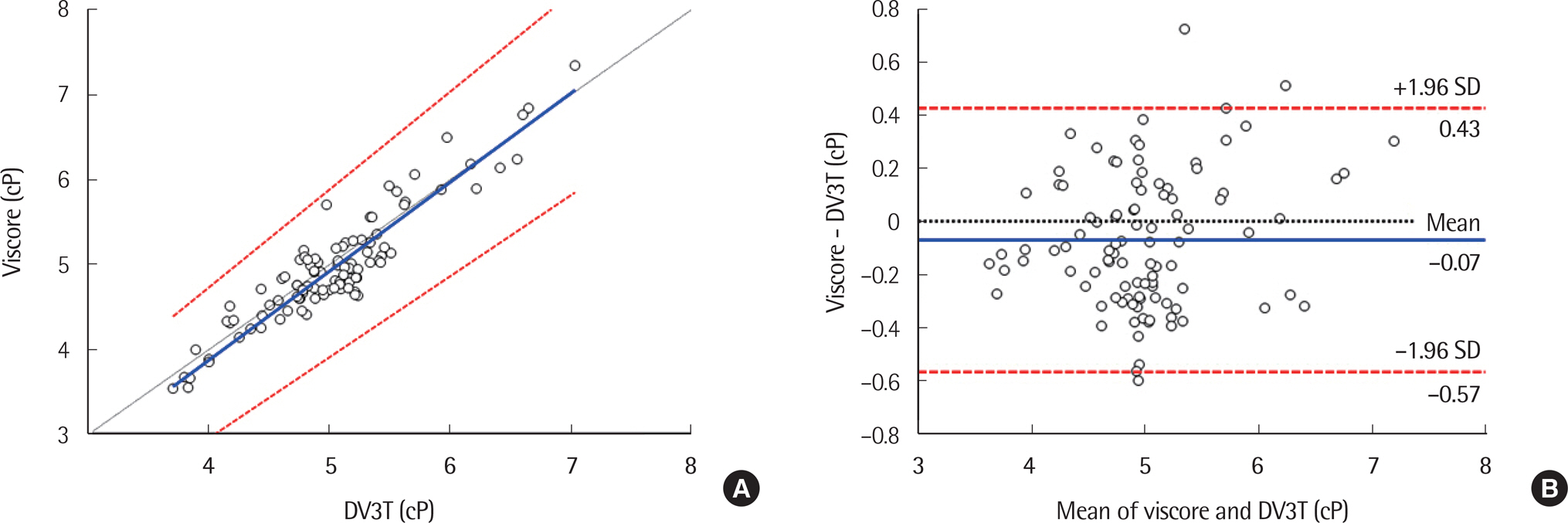Lab Med Online.
2018 Jan;8(1):1-6. 10.3343/lmo.2018.8.1.1.
Analytical Performance and Reference Interval of a Microfluidic Viscometer, Viscore-300 for the Measurement of Whole Blood Viscosity
- Affiliations
-
- 1Department of Laboratory Medicine, Chonnam National University Hwasun Hospital, and Chonnam National University Medical School, Hwasun, Korea. mgshin@chonnam.ac.kr
- 2Environmental Health Center for Childhood Leukemia and Cancer, Chonnam National University Hwasun Hospital, and Chonnam National University Medical School, Hwasun, Korea.
- 3College of Korean Medicine, Dongshin University, Naju, Korea.
- 4School of Electronics and Computer Engineering, College of Engineering, Chonnam National University, Gwangju, Korea.
- KMID: 2398412
- DOI: http://doi.org/10.3343/lmo.2018.8.1.1
Abstract
- BACKGROUND
Whole blood viscosity (WBV) refers to the internal resistance that occurs when blood flows through blood vessels. WBV is known to be related to many diseases including cardiovascular and neurovascular diseases. We have investigated the analytical performance and established reference intervals for a newly developed microfluidic viscometer, Viscore-300 (NanoBiz, Korea), used for the measurement of WBV.
METHODS
We performed a precision test of 240 measurements over 20 days using three control materials. For evaluation of repeatability, a total of 60 WBV measurements were made in 3 whole blood samples 20 times a day. A total of 100 whole blood samples were used to evaluate the accuracy of the Viscore-300 in comparison to a rotating viscometer, DV3T (Brookfield, USA), in accordance with the the Clinical and Laboratory Standards Institute's guidelines. To establish the reference intervals, 122 healthy individuals were enrolled in this study.
RESULTS
The precision and repeatability results showed that the CV was less than 5% for three samples and two shear rates. In the accuracy test, the mean differences between two viscometers were 0.09 cP (0.9%) and −0.07 cP (−1.4%) at shear rates of 10 s−1 and 300 s−1, respectively. The reference intervals of WBV for men were 6.88-13.52 cP at 10 s−1 and 4.32-6.43 cP at 300 s−1; those of women were 5.74-13.29 cP at 10 s−1 and 3.60-6.12 cP at 300 s−1.
CONCLUSIONS
Viscore-300 showed excellent precision and accuracy and it might be a good instrument for reporting WBV quickly and accurately.
Figure
Cited by 1 articles
-
Establishing Reference Intervals of Whole Blood Viscosity in a Korean Population Using a Cone-Plate Viscometer
Mikyoung Park, Hanah Kim, Hee-Won Moon, Mina Hur, Yeo-Min Yun
Lab Med Online. 2021;11(3):162-170. doi: 10.47429/lmo.2021.11.3.162.
Reference
-
1.Junker R., Heinrich J., Ulbrich H., Schulte H., Rainer Schönfeld R., Köhler E, et al. Relationship between plasma viscosity and the severity of coronary heart disease. Arterioscler Thromb Vasc Biol. 1998. 18:870–5.
Article2.Fossum E., Hoieggen A., Moan A., Nordby G., Velund TL., Kjeldsen SE. Whole blood viscosity, blood pressure and cardiovascular risk factors in healthy blood donors. Blood Press. 1997. 6:161–5.
Article3.Song SH., Kim JH., Lee JH., Yun YM., Choi DH., Kim HY. Elevated blood viscosity is associated with cerebral small vessel disease in patients with acute ischemic stroke. BMC Neurol. 2017. 17:20.
Article4.Rosencranz R., Bogen SA. Clinical laboratory measurement of serum, plasma, and blood viscosity. Am J Clin Pathol. 2006. 125:S78–86.
Article5.Clinical and Laboratory Standards Institute. Evaluation of precision performance of quantitative measurement methods; approved guide-line—2nd ed. CLSI document EP05-A3. Wayne, PA: Clinical and Laboratory Standards Institute. 2014.6.Clinical and Laboratory Standards Institute. Measurement procedure comparison and bias estimation using patient samples; approved guide-line—3rd ed. CLSI document EP09-A3. Wayne, PA: Clinical and Laboratory Standards Institute. 2013.7.Kim H., Cho YI., Lee DH., Park CM., Moon HW., Hur M, et al. Analytical performance evaluation of the scanning capillary tube viscometer for measurement of whole blood viscosity. Clin Biochem. 2013. 46:139–42.
Article8.Jung JM., Lee DH., Kim KT., Choi MS., Cho YG., Lee HS, et al. Reference intervals for whole blood viscosity using the analytical performance-evaluated scanning capillary tube viscometer. Clin Biochem. 2014. 47:489–93.
Article9.Clinical and Laboratory Standards Institute. Defning, establishing, and verifying reference intervals in the clinical laboratory; approved guideline—3rd ed. CLSI document EP28-A3c. Wayne, PA: Clinical and Laboratory Standards Institute. 2008.10.R Core Team. R: a language and environment for statistical computing [Internet]. Vienna, Austria: R Foundation for Statistical Computing, 2016. Available from:. https://www.R-project.org/.11.Froom P. Blood viscosity and the risk of death from coronary heart disease. Eur Heart J. 2000. 21:513–4.12.Minato S., Takenouchi A., Uchida J., Tsuboi A., Kurata M., Fukko K, et al. Association of whole blood viscosity with metabolic syndrome in type 2 diabetic patients: independent association with post-breakfast tri-glyceridemia. J Clin Med Res. 2017. 9:332–8.
Article13.Kang YJ., Yoon SY., Lee KH., Yang S. A highly accurate and consistent microfuidic viscometer for continuous blood viscosity measurement. Artif Organs. 2010. 34:944–9.14.Kang YJ., Yang S. Integrated microfuidic viscometer equipped with fuid temperature controller for measurement of viscosity in complex fuids. Microfuid Nanofuidics. 2013. 14:657–68.
- Full Text Links
- Actions
-
Cited
- CITED
-
- Close
- Share
- Similar articles
-
- Establishing Reference Intervals of Whole Blood Viscosity in a Korean Population Using a Cone-Plate Viscometer
- Effect of Physical Vibration on Blood Viscosity
- Development of the Unsteady Capillary Tube Viscometer and Viscosity Measurement of Blood Analogue Fluid
- Fork Test: A New Simple and Reliable Viscosity Measurement for Dysphagia Diet
- Performance Evaluation of Serum IgD Quantification by the SPAPLUS Turbidimetric Analyzer and Determination of a Reference Interval of IgD in the Korean Population



